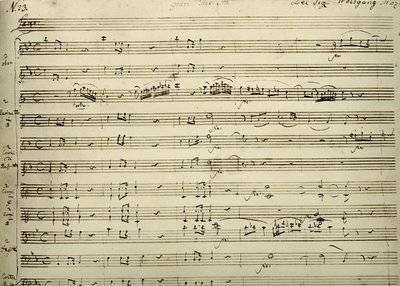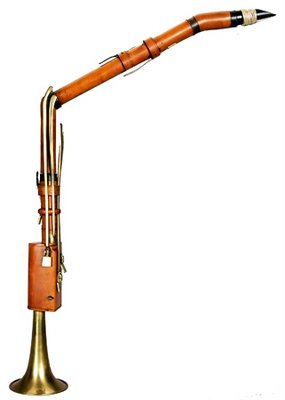OAE @ LOC
 Mozart, Gran Partitta, K. 361, holograph score, Library of Congress |
Daniel Ginsberg, Orchestra of the Age of Enlightenment (Washington Post, December 9) |
 "The basset horn, which sounds with a diffuse golden tone and looks like a broken clarinet with a nozzle at the base." -- Daniel Ginsberg, Washington Post |
The inferior nature of these compositions was made explicit by the little bon-bon the three players offered as dessert, Mozart's Canonic Adagio (F major, K. 484d [410]). If the Gran Partitta, now dated to 1784, shows leagues of development in Mozart's compositional style over K. 375, this enigmatic miniature, from late 1785 (actually scored for two basset horns and bassoon but played here with the three basset horns), is even more striking. Certainly shaming Stadler's little ditties, the Adagio feels quite like a sort of personal experiment, Mozart exploring the counterpoint and adventurous harmony he had been studying in the music of J. S. Bach. One audience member called out for the little piece, over in a minute or two, to be played again, but he was not obliged.
The Library of Congress owns the holograph score (page shown above) of the Gran Partitta (Serenade in B-Flat Major, K. 361), and they have published a facsimile edition of it. The critical edition, edited from the holograph and other primary sources by Neal Zaslaw and Daniel Neeson for the Neue Mozart-Ausgabe, finally dispelled the misconceptions about this work, which date back to "editions" made in the years after the composer's death. It added a level of significance to see the page in Mozart's hand in a case outside the auditorium. While the intellectual and technical qualities of this concert certainly impressed, musically one sensed something missing at times. This was typified in the Gran Partitta's glorious Adagio movement (which makes a memorable appearance in the film Amadeus), dashed off at a tempo closer to Andante than Adagio. The result was disappointingly prosaic. All, or almost all, of the surface details were there, but at times like this it was only an outside sheen.
The next concert in the Library of Congress series (December 15, 8 pm) is an all-Schumann program played by Joshua Bell (violin), Paul Neubauer (viola), Steven Isserlis (cello), and Jeremy Denk (piano).





















































No comments:
Post a Comment